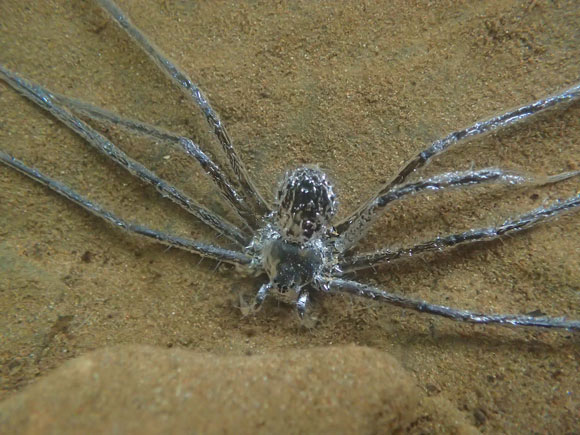A team of scientists from Binghamton University, the Amazon Conservatory for Tropical Studies, the California State University Sacramento and the Universidade de Aveiro has documented the prolonged underwater refuge use (over 30 minutes) of Trechalea extensa following pursuit by a perceived threat.

While submerged, Trechalea extensa uses a film of air to hide from predators. Image credit: Lindsey Swierk.
Trechalea extensa is a large species of Neotropical ‘semi-aquatic’ spider in the family Trechaleidae.
It can be found in Mexico, Guatemala, Honduras, Nicaragua, Costa Rica and Panama.
Binghamton University researcher Lindsey Swierk and colleagues observed Trechalea extensa fleeing from humans and hiding underwater.
“For a lot of species, getting wet and cold is almost as risky to survival as dealing with their predators to begin with,” Dr. Swierk said.
“Trechalea spiders weren’t previously known to hide underwater from threats — and certainly not for so long.”
Trechalea extensa spent about 30 minutes underwater. While submerged, it kept a ‘film’ of air over its entire body.
The researchers suspect that the fuzzy hairs that cover its body help it to maintain this film of air, which helps to prevent thermal loss while underwater, or to prevent water from entering the spider’s respiratory organs.
“The film of air surrounding the spider when it is underwater appears to be held in place by hydrophobic hairs covering the spider’s entire body surface,” Dr. Swierk said.
“It’s so complete that the spider almost looks like it’s been dipped in silver. The film of air might serve to keep the respiratory openings away from water, since these spiders are air-breathing.”
“The film of air might also help to minimize thermal loss to the cold stream water that the spider submerges itself in.”
This observation provides new insight into how species can cope with the problem of finding refuge underwater.
“These spiders, and any animal hiding from predators in general, have to do their best to manage risk,” Dr. Swierk said.
“Risk of predation, yes, but also risk of the costs they’ll experience by fleeing.”
“For some species that means leaving territory or mates unguarded, or maybe spending stored energy in a sprint.”
“In this species, potential risks of underwater refuge use can include lack of respiration and a loss of body heat.”
“There are many more questions to dig into starting from this first observation.”
The team’s paper was published in the journal Ethology.
_____
Lindsey Swierk et al. Diving behavior in a Neotropical spider (Trechalea extensa) as a potential antipredator tactic. Ethology, published online April 11, 2022; doi: 10.1111/eth.13281







